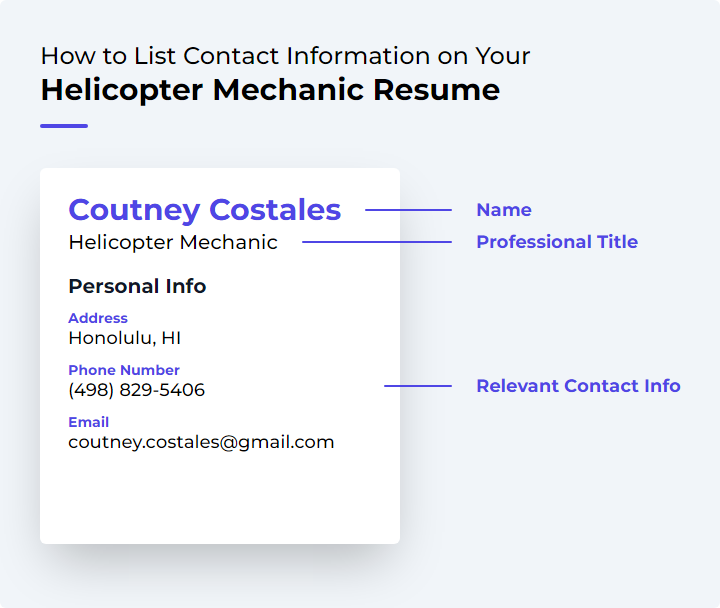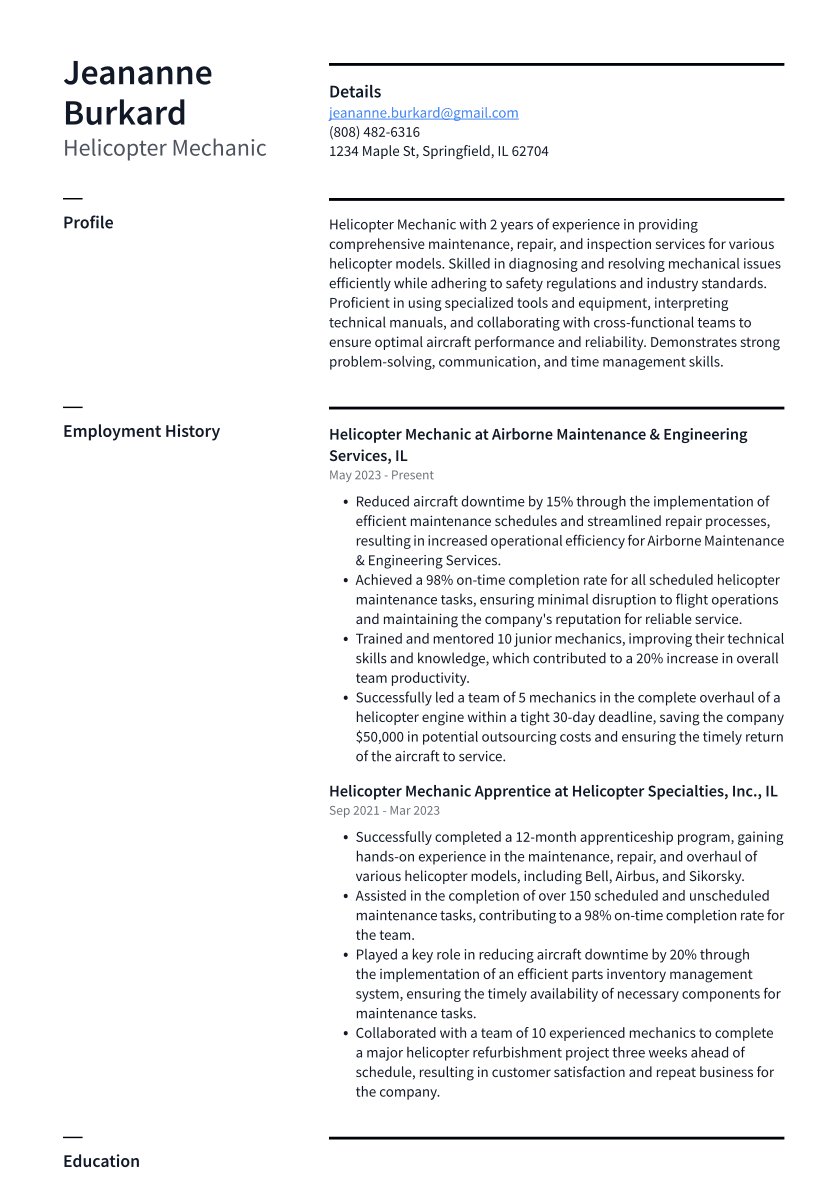Helicopter Mechanic Resume Examples
Writing a great helicopter mechanic resume is important because it is one of the first things a potential employer will see when they are considering you for a position. It is your opportunity to make a good first impression and sell yourself as the best candidate for the job.
Create your resume
Select from 7 professional resume templates
If you're looking for inspiration when it comes to drafting your own helicopter mechanic resume, look no further than the samples below. These resumes will help you highlight your experience and qualifications in the most effective way possible, giving you the best chance of landing the helicopter mechanic job you're after.
Essential Components of a Helicopter Mechanic Resume
A helicopter mechanic's resume is a vital document that showcases your skills, experience, and qualifications in aircraft maintenance. It serves as your professional representation to potential employers, highlighting your expertise in troubleshooting, repairing, and performing routine maintenance on helicopters.
Your resume should be well-structured and comprehensive, featuring essential sections such as contact information, an objective statement, a summary of skills, work history, education, certifications, and references. In the following sections, we will delve into each of these components, discussing their importance and what they should encompass.
Additionally, we will provide tips on how to make each section stand out to attract potential employers. Keep in mind that concise sentences enhance readability and comprehension.
1. Contact Information
The "Contact Information" section is a fundamental part of any resume, including that of a helicopter mechanic. It allows potential employers to reach out to you for interviews or further discussions.

Position this section at the top of your resume, including your full name, address (city and state suffice), phone number, and a professional email address. Ensure all information is current and accurate.
Your name should be in bold and larger font to draw attention. Provide a reliable phone number, preferably a mobile number, with a professional voicemail message. Your email address should reflect professionalism, typically incorporating your first and last names.
In today's digital age, consider adding your LinkedIn profile or other relevant social media handles to your contact information, ensuring they are professionally maintained and reflect your latest achievements.
First impressions matter, so ensure this section is clear and easily accessible to set a positive tone for the rest of your resume.
2. Objective Statement
The objective statement is a concise declaration of your career goals and the value you intend to add to a potential employer's organization. As a helicopter mechanic, highlight your dedication to safety, technical expertise, or extensive field experience.
For example: "Detail-oriented Helicopter Mechanic with over 5 years of experience in maintaining and repairing rotary-wing aircraft seeks a challenging role. Skilled in troubleshooting complex mechanical issues, adhering to safety protocols, and improving operational efficiency."
This statement succinctly conveys your experience, key skills, and career objectives, demonstrating your commitment to the profession.
Customize your objective statement for each job application, aligning it with the job description to show employers your suitability for the role.
Related: Top Helicopter Mechanic Resume Objective Examples
3. Skills and Competencies
The "Skills and Competencies" section is a showcase of your technical knowledge and soft skills relevant to the role of a helicopter mechanic. Include:
- Technical Skills: Proficiency in helicopter systems such as engines, hydraulics, rotors, and avionics, as well as the use of tools and equipment for repairs.
- Mechanical Aptitude: Ability to apply mechanical concepts to problem-solving, including troubleshooting, repairing, and installing helicopter components.
- Detail-oriented: Attention to detail is critical in aircraft maintenance to prevent errors that could lead to serious consequences.
- Physical Stamina: The job often requires lifting heavy objects and working in challenging conditions.
- Problem-solving Skills: Quick identification and resolution of issues are essential in this field.
- Communication Skills: Clear communication of technical information to colleagues, pilots, and officials is necessary.
- Safety Compliance: In-depth knowledge of and adherence to aviation safety regulations.
- Computer Skills: Familiarity with computerized diagnostic tools and maintenance software.
- Certifications: Highlight any relevant certifications, such as FAA certification, to demonstrate your qualifications.
- Teamwork Skills: Ability to collaborate effectively with a maintenance team.
By presenting these skills, you illustrate your capability to perform routine maintenance and solve complex problems while adhering to safety standards.
Related: Helicopter Mechanic Skills: Definition and Examples
4. Work Experience
The "Work Experience" section is where you detail your practical experience, showcasing your ability to apply theoretical knowledge in real-world situations.
List your previous positions in reverse chronological order, including job titles, employers' names and locations, and dates of employment. Under each role, provide a summary of your responsibilities and achievements, emphasizing tasks such as diagnosing mechanical issues, performing maintenance checks, replacing defective parts, and maintaining service records.
Quantify your accomplishments when possible to strengthen your resume. For example: "Reduced downtime by 20% through the implementation of an improved preventive maintenance schedule."
If you've progressed within a single company, list each position to show your growth and increasing responsibility.
The goal is to give potential employers a clear picture of your capabilities based on your past successes as a helicopter mechanic.
5. Education and Certifications
Your Education and Certifications are critical in demonstrating your formal training and qualifications for the role of a helicopter mechanic.
Begin with your educational background, including high school and any post-secondary education, such as an Associate's or Bachelor’s degree in Aviation Maintenance Technology or related fields.
Certifications are equally important, particularly those issued by the Federal Aviation Administration (FAA) in the United States, such as Airframe and Powerplant (A&P) certifications. Mention any additional certifications, such as Inspection Authorization (IA) or manufacturer-specific training, that enhance your expertise.
Continuing education and professional development should also be highlighted to show your commitment to staying current in the field.
List your educational and certification details clearly, including institutions, degrees or certificates earned, dates, and honors.
Related: Helicopter Mechanic Certifications
6. Licenses and Certifications (Specific to Aviation)
Highlighting Licenses and Certifications specific to aviation is crucial on a helicopter mechanic's resume, as they validate your expertise and compliance with industry standards.
- Federal Aviation Administration (FAA) Certification: Essential for helicopter mechanics, confirming knowledge of aircraft components and systems.
- Inspection Authorization (IA): Allows certified mechanics to conduct detailed inspections and approve aircraft for service.
- Military Training Certificates: Specialized training from military service can be highly valuable.
- Manufacturer-specific Certifications: Indicate specialized knowledge of particular helicopter models.
- Aviation Maintenance Technician (AMT) Awards: Recognition from the FAA for ongoing professional development.
- Other relevant certifications: Include OSHA safety certifications or EPA certifications for hazardous materials management.
These credentials not only demonstrate your dedication to maintaining expertise but also distinguish you as a highly qualified candidate.
Related: Helicopter Mechanic Certifications
7. References
The "References" section provides potential employers with contacts who can attest to your skills and work ethic.
Choose references who can vouch for your helicopter mechanic expertise, such as former supervisors, colleagues, or clients. Obtain their consent and confirm their contact information before listing them.
Typically, three to five references are sufficient. Provide their name, relationship to you, phone number, email address, and a brief note on what aspects of your work they can endorse.
This section should be concise, supporting the information presented in your resume. Well-selected references can significantly bolster the credibility of your resume and increase your chances of securing the desired position.
